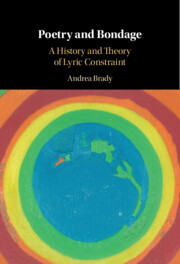Book contents
- Poetry and Bondage
- Poetry and Bondage
- Copyright page
- Dedication
- Contents
- Illustrations
- Acknowledgements
- Introduction The Fetters of Verse
- Part I Lyric Cells
- Chapter 1 The Music of Fetters
- Chapter 2 The Ligature
- Chapter 3 Each in Their Separate Hell
- Chapter 4 Hours of Lead
- Part II The Songs of Slavery
- Part III Pleasures and Ornaments
- Index
Chapter 3 - Each in Their Separate Hell
Solitary Confinement in the Long Nineteenth Century
from Part I - Lyric Cells
Published online by Cambridge University Press: 08 October 2021
- Poetry and Bondage
- Poetry and Bondage
- Copyright page
- Dedication
- Contents
- Illustrations
- Acknowledgements
- Introduction The Fetters of Verse
- Part I Lyric Cells
- Chapter 1 The Music of Fetters
- Chapter 2 The Ligature
- Chapter 3 Each in Their Separate Hell
- Chapter 4 Hours of Lead
- Part II The Songs of Slavery
- Part III Pleasures and Ornaments
- Index
Summary
This chapter offers a history of solitary confinement as a disciplinary technique, which emerged in the late eighteenth century as a replacement for the chaotic and degrading spectacle of corporal punishment. Key to that history are the ‘separate’ and the ‘silent’ regimes, whose most influential exponents were in the US, at prisons in Philadelphia (Eastern State) and New York (Auburn). The chapter uses the figure of the chaplain, and the inventive ways prisoners circumvented controls on their speech and inspection of their souls, to contextualise the solitude and introspection of the Romantic lyric. These contexts are rendered much more specific in readings of Wordsworth’s poetry of solitude and of penal discipline, and his evolution from the compassionate friend of ‘The Convict’ in Lyrical Ballads to the patron of capital punishment in his ‘Sonnets upon the Punishment of Death’.
Keywords
- Type
- Chapter
- Information
- Poetry and BondageA History and Theory of Lyric Constraint, pp. 83 - 111Publisher: Cambridge University PressPrint publication year: 2021

